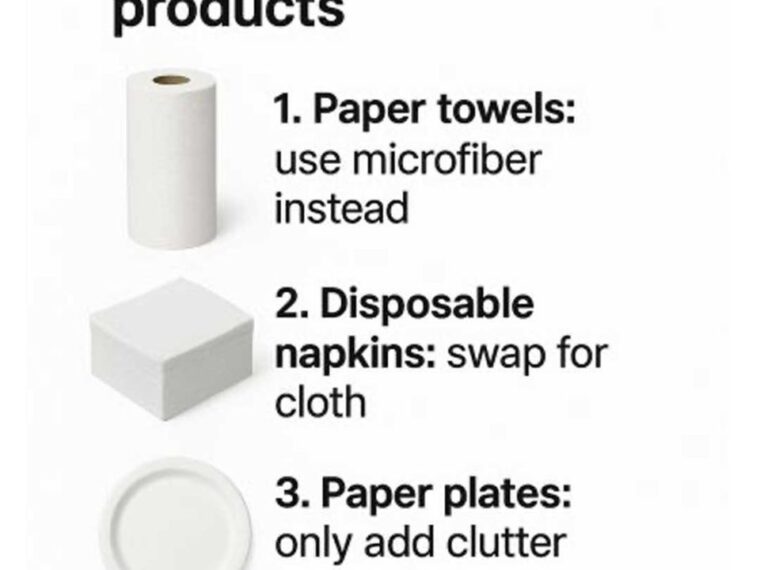In today’s world, sustainability and cost-efficiency are becoming increasingly important. Many of us are looking for ways to reduce waste and save money. A significant area where we can make improvements is with the everyday paper products we use. While these items may seem small and inconsequential, they can add up to a significant expense over time and contribute to environmental degradation.
By making conscious choices to eliminate or replace certain paper products with more sustainable alternatives, we not only save money but also reduce our environmental footprint. Here, we explore ten common paper products that you can stop buying in favor of more sustainable and cost-effective options.
1. Stop Buying Paper Towels: Switch to Microfiber Cloths
Paper towels are a staple in many households, but their convenience comes at a cost. Each year, Americans spend over $5.7 billion on paper towels, which often end up in landfills. Instead of buying endless rolls of paper towels, consider switching to microfiber cloths. These cloths are highly absorbent, reusable, and can last for hundreds of washes. A single microfiber cloth can replace dozens of rolls of paper towels, saving you money and reducing waste.
Microfiber cloths are also more effective at cleaning because their fibers are designed to pick up more dirt and bacteria than paper towels. By making the switch, you’ll not only save money but also improve the cleanliness of your home.
2. Ditch Disposable Napkins: Embrace Reusable Cloth Napkins
Disposable napkins are another product that contributes to unnecessary waste and expense. The average American uses about 2,200 paper napkins each year. Instead, invest in a set of reusable cloth napkins. Not only do they add a touch of elegance to your dining experience, but they can also be reused for years.
Cloth napkins are easy to wash and maintain. A set of 12 cloth napkins, which can be purchased for the price of a few packs of paper napkins, can last through hundreds of meals. Over time, you’ll save money and reduce the waste generated from single-use paper napkins.
3. Say No to Paper Plates: Opt for Durable Alternatives
Paper plates are convenient, especially for parties and picnics, but they are not environmentally friendly. Instead of using disposable paper plates, consider investing in durable, reusable alternatives such as melamine or bamboo plates. These materials are lightweight, durable, and can be used repeatedly.
While the upfront cost of reusable plates may be higher, they quickly pay for themselves through repeated use. Additionally, by reducing your reliance on single-use paper plates, you contribute to less waste and a healthier planet.
4. Forget About Coffee Filters: Try Reusable Mesh Filters
Coffee lovers often go through a lot of paper filters, which can add up in cost and waste. A more sustainable and cost-effective option is to use a reusable mesh coffee filter. These filters are made from stainless steel or other durable materials and can last for years.
Reusable coffee filters not only save you money but also allow more flavorful oils to pass through, resulting in a richer cup of coffee. By making the switch, you reduce waste and enjoy a better coffee experience.
5. Reconsider Paper Notebooks: Go Digital with Apps
In the digital age, paper notebooks are becoming less necessary. Instead of filling your shelves with notebooks, consider using digital note-taking apps like Evernote, OneNote, or Google Keep. These apps allow you to organize your notes, set reminders, and even share notes with others.
Going digital means you save money on buying notebooks and pens, and you reduce paper waste. Plus, digital notes are searchable, making it easier to find the information you need quickly.
6. Avoid Paper Receipts: Choose Digital Receipts Instead
Paper receipts may seem like a small issue, but they contribute to significant paper waste. Many retailers now offer digital receipts, which are sent directly to your email or phone. Opting for digital receipts not only reduces paper waste but also keeps your transactions organized in one place.
Digital receipts are easy to store and access, eliminating the need for physical filing systems. By choosing digital, you save paper, keep your records tidy, and have easy access to your purchase history.
7. Eliminate Paper Gift Wrap: Use Reusable Gift Bags
Gift-giving often involves wrapping paper, which is used once and then discarded. Instead, consider using reusable gift bags or fabric wraps. These alternatives are not only eco-friendly but also add a unique touch to your gifts.
Reusable gift bags can be used repeatedly for different occasions, saving you money in the long run. Additionally, they come in various sizes and designs, making them suitable for any gift-giving event.
8. Skip Paper Calendars: Adopt Digital Planning Tools
While paper calendars are traditional, they lack the flexibility and functionality of digital planning tools. Apps like Google Calendar or Microsoft Outlook allow you to easily manage your schedule, set reminders, and share events with others.
Digital calendars are always accessible from your phone or computer, ensuring you never miss an appointment. By going digital, you save money on buying calendars each year and reduce paper waste.
9. Sideline Paper Checkbooks: Move to Mobile Banking
With the rise of mobile banking, paper checkbooks are becoming obsolete. Most banks offer mobile apps that allow you to transfer money, pay bills, and even deposit checks without the need for paper. This not only saves you the cost of checkbooks but also streamlines your financial management.
Mobile banking is secure and convenient, giving you access to your accounts anytime, anywhere. By embracing digital banking, you reduce paper usage and enjoy more efficient financial management.
10. Reduce Paper Magazines: Subscribe Online
Paper magazines can be costly and clutter your home with unnecessary paper. Many publications now offer online subscriptions, which often come at a lower cost than their print counterparts. Online magazines are accessible from any device, allowing you to read your favorite articles on the go.
By switching to digital magazines, you save money, reduce paper waste, and still enjoy the content you love. Plus, digital subscriptions often come with additional multimedia content, enhancing your reading experience.




